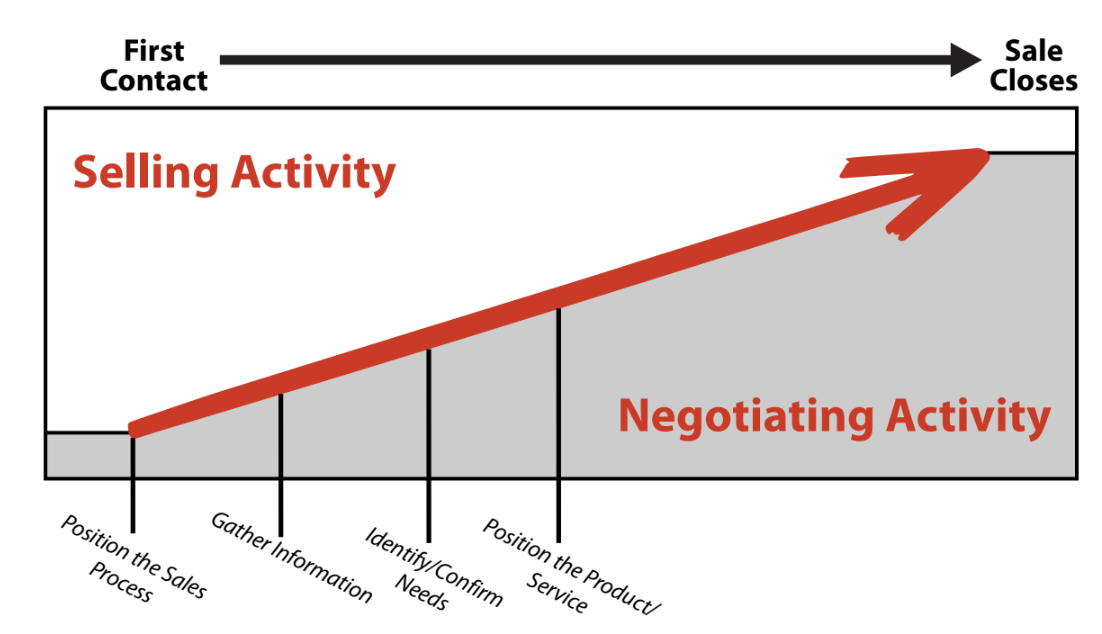The most important aspect of negotiation is often not about the product or service, but about the sales process itself. This is why you must develop a new skill: Positioning the Sales Process.

How to Position the Sales Process Effectively
How you position your sales process is your opportunity to set the tone, direction, and narrative for your entire on-going negotiation. Failure to do so effectively is only going to stack up the odds against you closing the best deal possible, if at all.
Additionally, once you’ve mastered the flow of a negotiation, you’ll also be able to expedite the process like a true professional, retaining as much value as possible and building a potentially fruitful long-term relationship along the way.
Step 1: Claim the leading role.
Effective negotiation is similar to dancing. One party tends to lead and the other follows, and occasionally the roles alternate. By establishing the lead role early on, you help to eliminate any early ambiguity and focus on the aspects that matter most.
The key is to focus on facilitating the next stage of gathering information to uncover needs, which can be phrased in different ways depending on your organization and sales structure. Essentially, you’re going to want to communicate something along the lines of either:
- “The way I/we like to work is (describe the process you recommend)…”
- “The way our customers tell us we work best is…”
For example, let’s assume you want to focus on communicating with the main people that have the green light to close the deal and cut you a check:
- “To achieve the best results for our customers, we find it most helpful to get all the key decision-makers involved early in our discussions. I recommend that we put together a meeting involving the two other department heads and that we also interview (etc)..”
Step 2: Explain your reasoning and establish collaboration.
Simply saying something like “this is the way we like to do it and that’s it” likely isn’t going to go over well with the other party. It’s important to explain why you’re structuring the sales process the way you are so that the other party views the ongoing conversation as a collaborative effort to hit a mutual goal that happens to be in their favor.
The dialogue is going to look something like:
- “So that (describe the general benefit to the customer)…”
Let’s continue with our example from above:
- “…so that we can make sure our proposal takes into consideration the needs of all departments from the beginning.”
Step 3: Establish the logic behind your reasoning.
Ultimately, the sales process needs to feel like it’s worth the other party’s time. If it doesn’t, you won’t get that critical buy-in and engagement you need to keep them interested enough to want to sign the deal.
The dialogue will look like:
- “The reason this is so important because (Choose one or two specific business advantages related to: expense reductions, increases in revenue, profitability, and productivity, process improvement, implementation efficiency, personal aspirations, other things of importance to the customer)”
Continuing with the example above:
- “My experience shows me that if I don’t understand all of the variables, we end up wasting time during the development of the solution, and can miss valuable opportunities to [save you money, boost your productivity, etc].”
Step 4: Paint a perfect (or nightmare) scenario
To handle further objections, it’s worth highlighting how a perfect or nightmare scenario can occur.
The dialogue is something like:
- “Let me give you an example…”
And now is your chance to set the scene:
- “I worked with a customer last month on a project like this one. The Marketing Manager of the company immediately got involved. It was her buy-in that…”
Or, alternatively with a nightmare scenario:
- “We worked with e customer last month on a similar project. The CEO was out on vacation and we spent hours attempting to hammer out a solution. Without his buy-in, the client’s company spent dozens of their, and our, precious time only to learn upon the CEO’s return that she was planning to shut down the business completely.”
While it’s usually more effective to focus on the positive, it’s more important to establish expectations early on.
Final Thoughts
Positioning the sales process effectively will have positive effects throughout the entire discussion with your client and beyond. It also helps establish yourself as a firm but fair negotiator that is focused on providing your clients with the highest amount of value.
Plan for success
Before your next negotiation, use our RED BEAR Negotiation Planner to develop your strategy and goals for a successful outcome.

